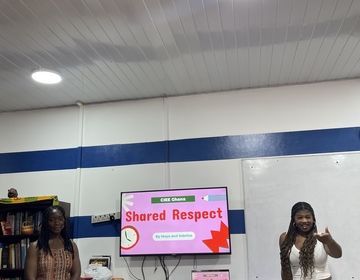“I did touch the King’s hand!”
The conclusion of the second week allowed for the Global Navigators to travel to the powerful Asante Region. Asante is the most heavily populated region in Ghana and Kumasi has the highest population of 36.1% of the regional population. The trip to Kumasi started early as Navigators slowly boarded the charted bus for the 5 hour journey. The first stop in the trip was to the Adanwomase Kente Village. Adanwomase has been the Asante King’s royal weaving settlement since the first apprentices returned from Bontuku. As told by the local guide, the Global Navigators learned of the traditions of Kente making (including meanings of the patterns, connection to the region, and the apprenticeship process) and witnessed the craftsmanship and precision of the weaving process at the local factory.
After a questionable 10 min interlude, a group of 3 students emerged as pseudo-elected village leaders, surprising their awaiting fellow participants. The Navigators watched as their guide, now revealed as a sub-chief of the village, introduced the new “village leaders”, assigned the role of group orator, and performed ceremonial greetings. The Navigators then participated in a group dance accompanied by a group of talented drummers. The day ended at a local hotel where the Navigators relaxed by the pool or took a much needed nap!
The return home on Sunday took an expected yet pleasant turn. After another dip in the pool and lunch, the Navigators traveled to the Manhyia Palace Museum for a deeper history lesson of the Asante Kingdom. As the group approached the compound there was an observable buzz in the air as the group learned that there was a festival to begin shortly. During the museum tour, the Navigators learned of historical facts including the timeline of the famed Golden Stool (gold-covered wooden stool, symbolizing unity and scarcity, and believed to hold the soul of the nation) the importance of women in the hierarchal structure, and the representation found in the Asante flag. The flag has three horizontal stripes: gold for mineral wealth, black for the Asante people, and green for the forests. The emblem in the center is the Golden Stool, a symbol of national unity and royal authority since the 18th century.
The participants that opted to enter the village festivities where surprised by the king’s precession! This group got the rare glimpse at the king, the Golden Stool, chiefs, and all the adorning gold jewelry and other accouchements worn by leaders. Nestled at the front of the crowd, Global Navigator Lucia was lucky enough to touch the hand of the king and to receive his affirmations. This was definitely a highlight of this incredible trip! As the group took the long trip home, they again reflected on their journey this far and brainstormed ways to maximize their last week of the program.
Asia
Twi word(s) of the day: me hene
me hene means my king/monarch
Related Posts
Student Project: Shared Respect
During this program, the participants worked in groups to create projects reflecting their experiential learning from the last three weeks. The following is a selection from Sabrina Addo and Maya... keep reading
Tying Up Loose Ends
With only a few days left in our program, we are embracing every opportunity to make lasting memories and reflect on our incredible journey. One of the highlights of this... keep reading
Visiting Ghana’s First Cocoa Farm
Student Blog Takeover: Milo and Anthea visit Ghana's first cocoa farm






